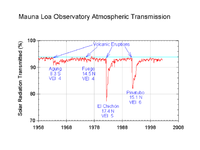
Photo from wikipedia
Abstract The effect of high anthropogenic aerosols on the aerosol optical and radiative properties was aggravated from west to east in China. The annual mean (from 2004 to 2007) aerosol… Click to show full abstract
Abstract The effect of high anthropogenic aerosols on the aerosol optical and radiative properties was aggravated from west to east in China. The annual mean (from 2004 to 2007) aerosol optical depth (AOD), Angstrom exponents (α), absorptive aerosol optical depth (AAOD), and single-scattering albedo (SSA) were from 0.16 to 0.73, from − 0.01 to 1.15, from 0.03 to 0.04, and from 0.78 to 0.94, respectively. In addition, the annual mean of aerosol direct radiative forcing at the top of the atmosphere (TOA) were from − 7.2 to 18.5 W/m 2 . High anthropogenic aerosol exhibited the effect of heating the atmosphere (ATM) (48–52 W/m 2 ) and cooling the surface (SFC) (− 48 to − 56 W/m 2 ) in eastern China. In Lanzhou where there is more serious pollution of heavy industry, aerosol-induced surface cooling reached − 61 W/m 2 . The radiative forcing was higher in winter and spring than that in summer and autumn. Aerosol heating effect on the atmosphere was obvious; there was significantly linear correlation between AOD and TOA, SSA and TOA. The slopes of AOD vs TOA were from − 20.8 to − 42.6. The slopes of SSA vs TOA were from − 58 to − 302. The aerosol was cooling the Earth-atmosphere system with AOD or SSA increasing. In the meantime, AAOD (x) exhibited significantly linear correlation with the heating effect in the atmosphere (ATM: y) (y = 1053.7x + 10.5, R 2 = 0.85). And the effect of AOD (x) on the SFC (y) cooling was also obvious (y = − 47.1x − 24.5, R 2 = 0.56). Therefore, the thermodynamic effects of anthropogenic aerosols on the atmosphere circulation and structure should be taken into consideration in East Asia.
Journal Title: Atmospheric Research
Year Published: 2017
Link to full text (if available)
Share on Social Media: Sign Up to like & get
recommendations!